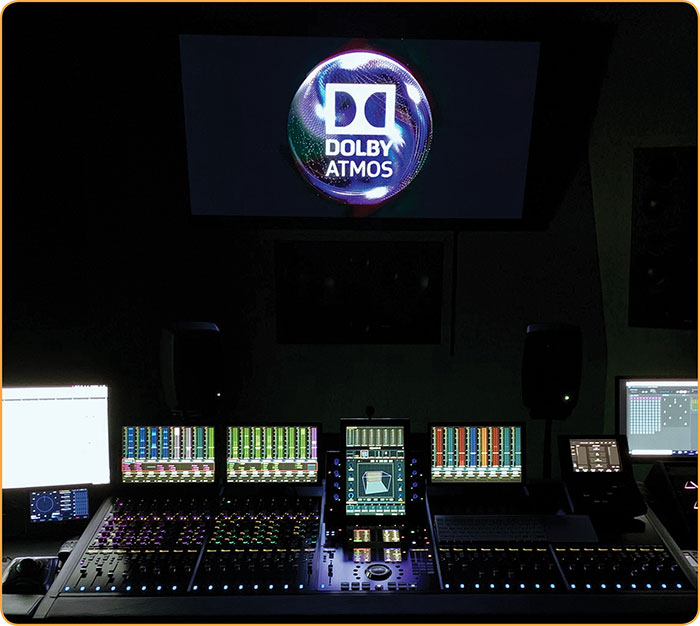THE FAMOUS ATMOS MIX
GALACTICA A transformed to a Dolby Atmos HE Room

A proud Farhad DadyBurjor poses for a pic in Famous Studio's new, lavish Dolby Atmos HE setup
Famous Digital Studios has once again upped the ante by offering clients an opportunity to push boundaries of creativity.
Farhad DadyBurjor, the man behind the design and building of the original Galactica A at Famous Studios is also the force and visionary behind the conceptualization and execution of this top-class Dolby Atmos HE room. "Famous has always been on the cutting edge of audio technology since I joined them in 1993. All the rooms we've built, and the audio technologies adopted in those rooms, have defined the industry and set standards for others to follow. We were the first to have a highly specified purpose designed room, first to have an entirely non-linear hard disk based workflow, when the rest of the industry was adopting the ADAT format, first to install Dolby Surround and then 5.1 in all our rooms. I would like to think that this is just a natural extension of our legacy in audio to current times," says DadyBurjor proudly.
The former Galactica A control room, capable of handling anything from background scoring to audio postproduction and album work in Famous Studio's Santacruz facility, has been retrofitted into a 7.1.4 Dolby Atmos HE certified mixing room. "Galactica A was not intended for Atmos HE, it was equipped for 5.1 surround audio, but was surprisingly easy to adapt that design and modify it for Atmos. The major change that had to be done structurally was tearing down the front speaker wall completely and building a new one to Dolby specifications. Galactica Studio A is a highly specified 7.1.4 Dolby Atmos HE certified mixing room, and I'm happy to say that the room has successfully passed Dolby Labs certification for Atmos HE with flying colours."
DadyBurjor himself designed and integrated the various systems for the new studio, with help and insights provided by Sreejesh Nair, Pro Audio Application Specialist at Avid and Bhaskar Pal, Senior Content Services Engineer at Dolby India. In order to achieve an acoustically correct environment for Dolby Atmos HE, DadyBurjor appointed acoustic consultancy firm Munro Associates. "We have always associated high quality room design with Munro Associates, and were the first to have a room designed by them in India, which grew into the largest market for them worldwide. For the record, all nine rooms that we've commissioned and built across our facilities over the years, have been designed by Munro Associates. The last three, as well as this Atmos HE room's design were all spearheaded by Kapil Thirwani and his team from Munro Acoustics India, who is no stranger to the industry in India, as you well know," says DadyBurjor. "As the previous iteration of the room always sounded superb, my design brief to Kapil was simple : change as little as you can, and as much as is required to conform to Dolby Atmos HE certification compliance totally. I'm happy to say the end result is all we wanted, thanks to Kapil's design work," he adds.
The monitors for the new studio are all custom-designed and built specifically for the room. Now up and running, Galactica A uses the three original custom-built Dynaudio Acoustics M3 monitors for the main LCR and eight new custom-built Dynaudio Acoustics surround and overhead speakers. "Since the room was already originally spec'd for 5.1 and already sounded very good, we saw no reason to change our monitoring setup. We just added 8 custom-built Dynaudio Acoustics surround and overhead speakers to the existing system, purchased from Dynaudio Acoustics with whom we have had a wonderful working relationship for over 25 years. The overheads have been positioned to fire at the mix position, exactly as per Dolby specifications."

Adorning the front speaker wall is a Dolby recommmended LG C8 4K HDR 65" monitor with Dolby Vision (which incidentally is also Netflix's reference monitor for audio) capable of playing Atmos content without speakers.
The room comprises of Genelec nearfields, an active 18" subwoofer, once again custom-built by Dynaudio Acoustics and is installed with a custom configured Avid S6-M40-32 fader console with dual Avid MTRX interfaces connected to a ProTools HDX|2 system, running 128 channels of MADI, 16 AES/EBU, and 24 analog IO simultaneously, purchased through Ansata Systems. "We also have a certified hardware Dolby Atmos HE Renderer and are capable of rendering final mix downs in the studio. We imported the Dolby Atmos HE renderer and the custom built Argosy table from RSPE in the US, and had a custom-built power supply for the console by AVS in Germany."
The amplifier rack contains a mix of six Dynaudio Custom amplifiers, with an aggregate power output of over 6500 watts. "As always, hardware multichannel reverb and loudness metering is provided by TC Electronic System 6000 and Clarity-M. Besides all the normal ProTools Ultimate software, we have possibly the most comprehensive set of plugins in the industry, including DSP versions of the entire Nugen Audio plugin collection," informs DadyBurjor.
It took three months for the studio to be specified for Atmos HE and the end-result is something that Dadyburjor can be proud of. "Building any studio is a strenuous exercise, especially in the planning stages. By rule of thumb, whatever your best time estimate is, it always doubles for some unforeseen reason or the other. And when you're talking about shutting down a working studio to create a new one, it becomes that much worse. I won't lie, it has been a trying three months, both professionally and personally for all of us involved. Other than that, it was a regular studio build with all the normal pitfalls and delays associated with it.
Commenting on Dolby's Design guidelines for the room, he says, "Dolby has provided a detailed spec sheet for Design Guidelines that is available from them on request. They are extremely detailed and would better serve the interests of your readers, rather than me trying to give a brief version of the same. Suffice to say, the tolerances are down to millimeters."
To explain the detail and precision with which the studio was built, DadyBurjor cites an anecdote, where he had to actually sit in a particular position on the console for hours, with strings tied to his ears and pinned to the front wall for exact measurements to be taken and after the studio was built, Dolby has used a laser rangefinder to verify all measurements. "All of us at Famous are extremely grateful to the team at the local Dolby India office and Munro Acoustics India, as the room sounds fabulous!!" he enthuses.
In Dolby Atmos HE, which is Atmos for Home Entertainment, the main difference is that mixes done for cinema do not translate well into the home environment, whether delivered on HD Blu Ray or OTT platforms. Therefore, one of the fundamental differences in Atmos HE is defined by the mix, taking place in a Dolby approved nearfield mixing room, and NOT a cinema mix room.
With very few Dolby certified Atmos HE studios in India and the concept still in its nascent stage, not many understand the intricacies. On paper, upgrading to Dolby Atmos is potentially as easy as adding four overhead speakers, but of course, it's not quite that simple. Dadyburjor clears the air surrounding this technology – "I think that it's very important to understand that both Dolby Atmos and Atmos HE are object based audio platforms, which is the fundamental difference. Consumers simplify that as having overhead sound sources, which adds another axis to the sound stage, but that is an oversimplification. In Atmos, the Dolby engine can render audio movements with scalability in the size of the listening environment on the fly. So, for example, you can mix on, say, a 7.1.2 system which is defined as 7.1 with 2 overhead channels, and any object based audio position in the 3D space will be calculated for the listening environment on the fly and rendered, regardless of the number of speaker arrays that it has. In Dolby Atmos HE, which is Atmos for Home Entertainment, the main difference is that mixes done for cinema do not translate well into the home environment, whether delivered on HD Blu Ray or OTT platforms. Therefore, one of the fundamental differences in Atmos HE is defined by the mix, taking place in a Dolby approved nearfield mixing room, and NOT a cinema mix room."

Dolby Atmos enables much finer control over individual sounds which can be placed and moved in three dimensional space. The green dots on the LG screen depict object positions in space. The ISD S6 PSU (Power Supply Unit), seen in the pic is a recently launched special power supply unit installed here for high-quality and interference-free power supply for the Pro Tools S6 M40 series control surface
For the engineer Dolby Atmos opens up huge possibilities for immersive mixing. "It definitely opens up huge possibilities, once you get your head around how it works. Simply put, it gives normal stereo, 5.1 and 7.1 audio wings, and allows for realism of movements to create a truly immersive experience. Just as surround first opened up a new axis of front/rear panning, object based audio has added one more axis of height into the mix. It enables both a massive amount of creative freedom as well as a huge responsibility for the mix engineer, to mix in good taste and not overdo surround and height panning just for the sake of it, as there are no "rules" for mixing," he says.
When queried about what his approach to creating mixes in this format would be and whether he would be mixing sessions entirely on Atmos, DadyBurjor says, "I would love to! While delivery specs of clients differ, there are almost always 7.1, 5.1, and stereo down-mix versions of the project included as part of the delivery spec. Current global mixing trends tend towards recommending mixing in Atmos regardless of whether the delivery spec calls for it or not, as the mix would be done once and be easily repurposed for any current 7.1 or 5.1 fold downs as well as future needs for Dolby Atmos. Thankfully, the beauty of the Dolby Atmos system is that it re-renders objects based on the information it has about every playback environment it is set up in. Therefore, if you'll permit me to say to say so, it is system agnostic in terms of number of speakers and setups, allowing for playback of the best possible version of what we mix in the studio."
Since ProTools already has embedded object based panning as well as support for the Dolby Atmos HE renderer, and the studio already has a Dolby Atmos HE hardware renderer, DadyBurjor does not use the Production Suite software introduced by Dolby. "The hardware renderer supports 128 inputs and outputs via MADI" he reiterates.
The advent of OTT platforms like Netflix and Amazon, streaming movies and web series mixed in Dolby Atmos, has accelerated the demand for immersive content and this segment is where DadyBurjor envisions the demand. "We expect the majority of our work to come from OTT Platforms, most of whom are producing local content, and there is a great demand for facilities to cater to that. We are also capable of doing work for film, stems as we have a hardware renderer and a project worked upon in this room can simply be taken to an Atmos Certified Cinema Mix stage and continued." Commenting on the demand for this service from the advertising industry, he says, "We have been doing 5.1 and even 7.1 mixes for the advertising industry for a while now, but we hope to take it to a new level with this system. There is not a large demand for it yet, but we expect it to grow exponentially."

Galactica A is installed with a custom configured Avid S6-M40-32 fader console with dual Avid MTRX interfaces connected to a ProTools HDX|2 system, running 128 channels of MADI, 16 AES/EBU and 24 analog IO simultaneously
With increase in demand for OTT content, there's no denying that for content providers security is more important than ever and the facility has ensured that the security concerns of the clients is taken very seriously. "We understand that just having a facility for them is not enough. To enable high data security, Famous has proactively taken a further step and the facility is MPAA compliant as well," he says. "We had multiple meetings with Amazon and Netflix before we built the studio to understand what their concerns were about the whole process and Netflix's greatest concern more than anything else, is security and most studios in India don't meet those standards," he adds.
A sound demo of Die Hard establishes the almost cinematic impact of the format. "This is the purpose of HE mixes being done in a smaller scaled near field environment. However, no matter how sophisticated the home environment (and I know of some home setups which would rival or outclass very good cinema halls) cinema is cinema, and the sense of "space" in a cinema hall cannot be totally replicated at home."